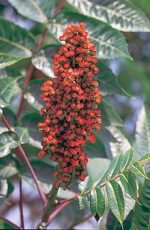 Also known as white sumac, upland sumac, and scarlet sumac, this suckering, deciduous shrub is a member of the cashew family, Anacardiaceae, that also includes smoke tree, mango, and poison ivy. It is native to northeastern US, occurs throughout much of the country, but is most common in the East where it is found in prairies, fields, abandoned farmland, woodland edges, roadsides, and railroad right of ways, often in dense colonies. The plants grow 8-20′ tall and have thick smooth stems that are hairless or covered with fine white hairs. The shiny dark green leaves are eighteen inches long and pinnately compound with nine to twenty seven leaflets. Leaflets are covered with fine white hairs on the backs and turn bright orange to red in autumn. Small, yellow-green male and female flowers appear in separate terminal panicles on different plants from late spring to early summer. The panicles are five to ten inches long and female flowers give way to erect, cone-shaped clusters of berry-like fruit up to eight inches tall. Each fruit is hairy, red when ripe turning brown with maturity, persistent into winter, and attractive to birds. Plants spread by seed and root stock and can be weedy and invasive but is an important food source for wildlife. It is drought tolerant and suitable for a xeriscape and for erosion control. The genus name, Rhus, is the Greek name for one species, Rhus coriaria. The specific epithet, glabra, is the Latin word meaning smooth, and refers to the stems.
Also known as white sumac, upland sumac, and scarlet sumac, this suckering, deciduous shrub is a member of the cashew family, Anacardiaceae, that also includes smoke tree, mango, and poison ivy. It is native to northeastern US, occurs throughout much of the country, but is most common in the East where it is found in prairies, fields, abandoned farmland, woodland edges, roadsides, and railroad right of ways, often in dense colonies. The plants grow 8-20′ tall and have thick smooth stems that are hairless or covered with fine white hairs. The shiny dark green leaves are eighteen inches long and pinnately compound with nine to twenty seven leaflets. Leaflets are covered with fine white hairs on the backs and turn bright orange to red in autumn. Small, yellow-green male and female flowers appear in separate terminal panicles on different plants from late spring to early summer. The panicles are five to ten inches long and female flowers give way to erect, cone-shaped clusters of berry-like fruit up to eight inches tall. Each fruit is hairy, red when ripe turning brown with maturity, persistent into winter, and attractive to birds. Plants spread by seed and root stock and can be weedy and invasive but is an important food source for wildlife. It is drought tolerant and suitable for a xeriscape and for erosion control. The genus name, Rhus, is the Greek name for one species, Rhus coriaria. The specific epithet, glabra, is the Latin word meaning smooth, and refers to the stems.
Type: Deciduous shrub
Outstanding Feature: Berries
Form: Rounded or sprawling
Growth Rate: Rapid
Bloom:Small yellow-green male and female panicles on different plants in spring
Size: 6-20′ H x 6-20′ W
Light: Full sun; tolerates some shade
Soil: Average to lean, moderately moist to dry, well-drained
Hardiness: Zones 3-9
Care: Prune in early spring to control size.
Pests and Diseases: Generally healthy but susceptible to leaf spot, rust, scale, aphids and mites.
Propagation: Seed, root cuttings
Photo Credit: Wikipedia